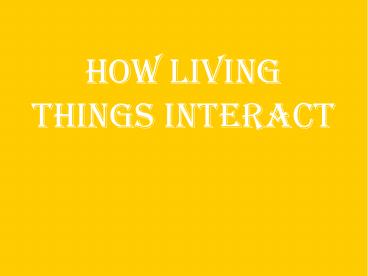How Living things interact - PowerPoint PPT Presentation
Title:
How Living things interact
Description:
How Living things interact Adapting to the Environment All organisms within ecosystems have a special set of characteristics that affect their ability to survive in ... – PowerPoint PPT presentation
Number of Views:313
Avg rating:3.0/5.0
Title: How Living things interact
1
How Living things interact
2
Adapting to the Environment
- All organisms within ecosystems have a special
set of characteristics that affect their ability
to survive in their environment
3
Natural Selection
- Natural Selection- A characteristic that makes an
individual better suited to its environment.
Eventually this trait may become common in that
species because it is passed from parent to
offspring.
4
Survival of the Fittest
- Ever heard of this? Organisms with unique
characteristics are better suited to survive in
their environment. They tend to survive. They
then pass these good traits on to their
offspring.
5
Adaptations
- A result of natural selection
- Adaptations- the behaviors and physical
characteristics that allow organisms to live
successfully in their environments. - If they do not well suited to survive in their
environment they will not reproduce as much.
What will happen to them?
6
What is a Niche?
- Each organism has a role in an ecosystem based on
its adaptations to its environment. Each
organisms role in its habitat is called its
niche. This involves the type of food they eat,
how it obtains food, and others that prey on
this organism. A niche is also the physical
conditions and how the organism reproduces.
7
Predator Adaptations
- An adaptation that helps them catch their prey.
For example a horse shoe bat sends out sound
waves and located its prey by listening for the
echo.
8
Prey Adaptations
- Organisms avoid being eaten by their predators by
using certain adaptations
9
Preys Defense Strategies
- Mimicry- disguising their appearance as a
threatening organism. - An example is this caterpillar. Its rear end
looks like a snake!!
10
(No Transcript)
11
Prey Adaptations
- Another defense strategy is camouflage
- Camouflage- when an organisms appearance blends
in with its typical surroundings
12
Another Defense Strategy
- Warning color- bright colored animals warn their
predators that they are poisonous, or just wont
taste good!
13
Types of Interactions
- Three types1) Competition- the struggle between
organisms to survive as they attempt to use the
same limited resource . If an animal has a
unique adaptation that reduces competition
between organisms.
14
The elf owl and the roadrunner both live in the
sanguaro desert and they both eat insects. They
compete for food, but do not occupy exactly the
same niche. While the roadrunner is mostly
active during the day, the owl is active during
the night. If these animals did share exactly
the same niche one of the species would
eventually die off.
15
Types of Interactions
- 2) Predation- when an organism kills another for
food
16
Types of Interaction
- Three types
- 3) Symbiosis- a close relationship between two
species that benefit at least one organism
17
Types of Symbiosis
- Mutualism- A relationship in which both species
benefit
18
Types of Symbiosis
- Commensalism- a relationship in which one species
benefits and the other species is neither helped
or harmed. (Not as common because most organisms
affect each other in some way)
19
Types of Symbiosis
- Parasitism- a relationship where one organism
benefits and the other is harmed. - The parasite benefits, the host is harmed. The
parasite usually does not kill the organism it
feeds on because if it does die, the parasite
loses its source of food/shelter
20
Types of Symbiosis
Moth mites almost always live in just one ear of
a moth. If they lived in both ears the moths
hearing would be so badly affected that it is
likely quickly caught and eaten by a predator,
such as a bat.
21
(No Transcript)
22
(No Transcript)
23
(No Transcript)































